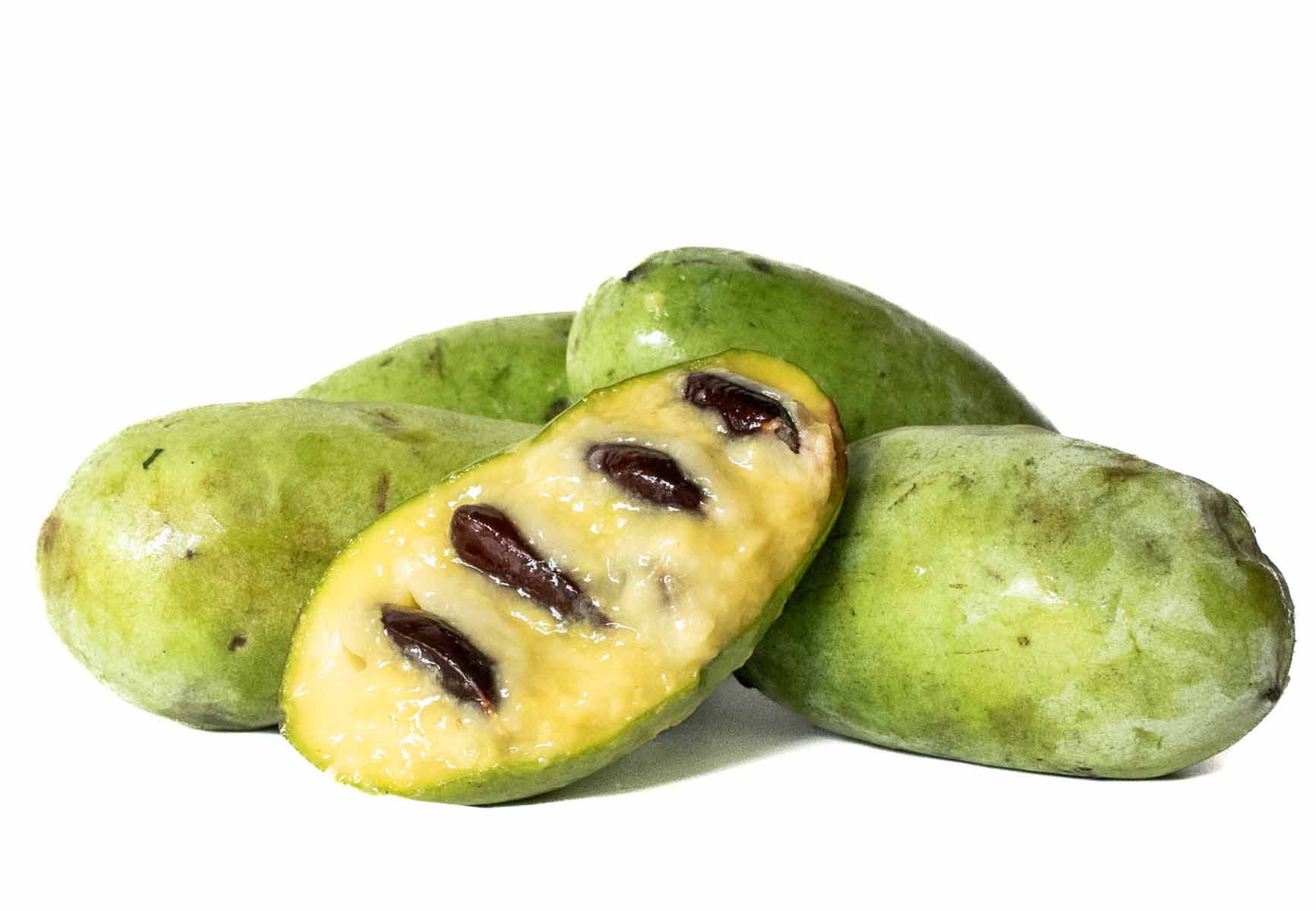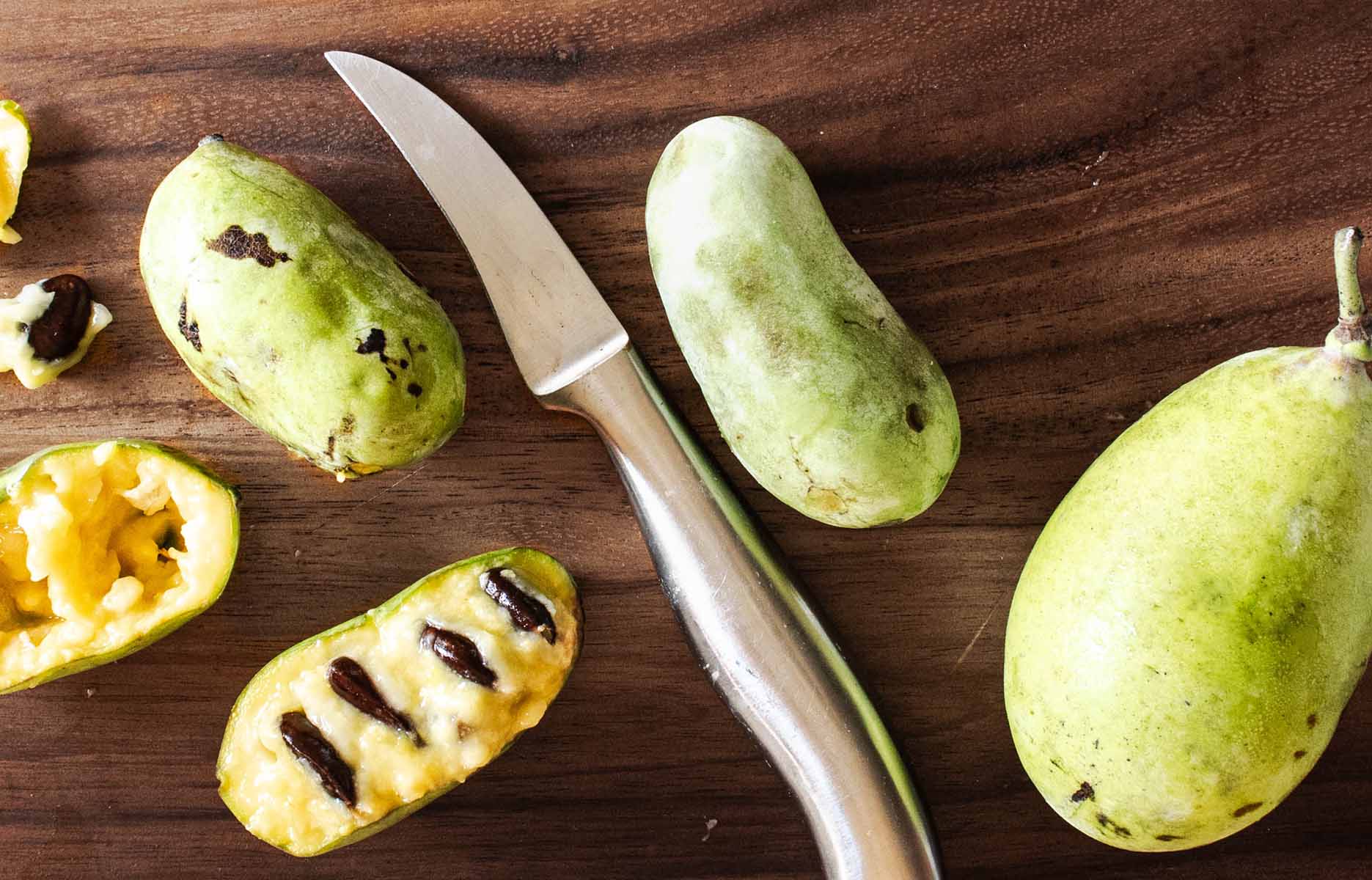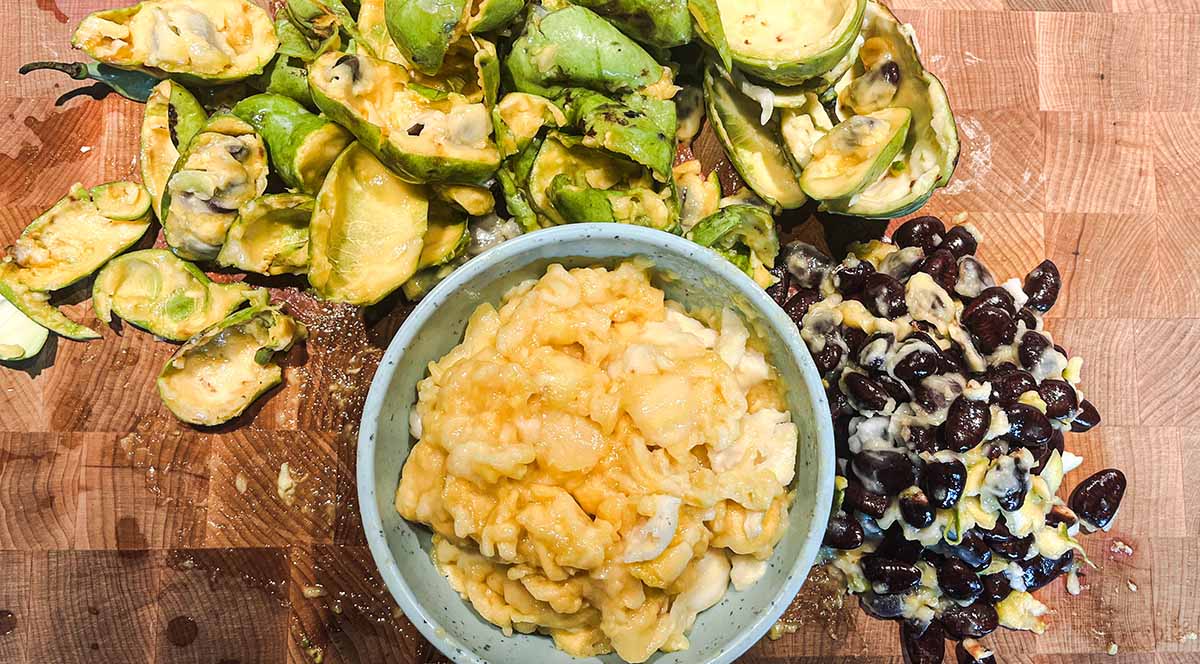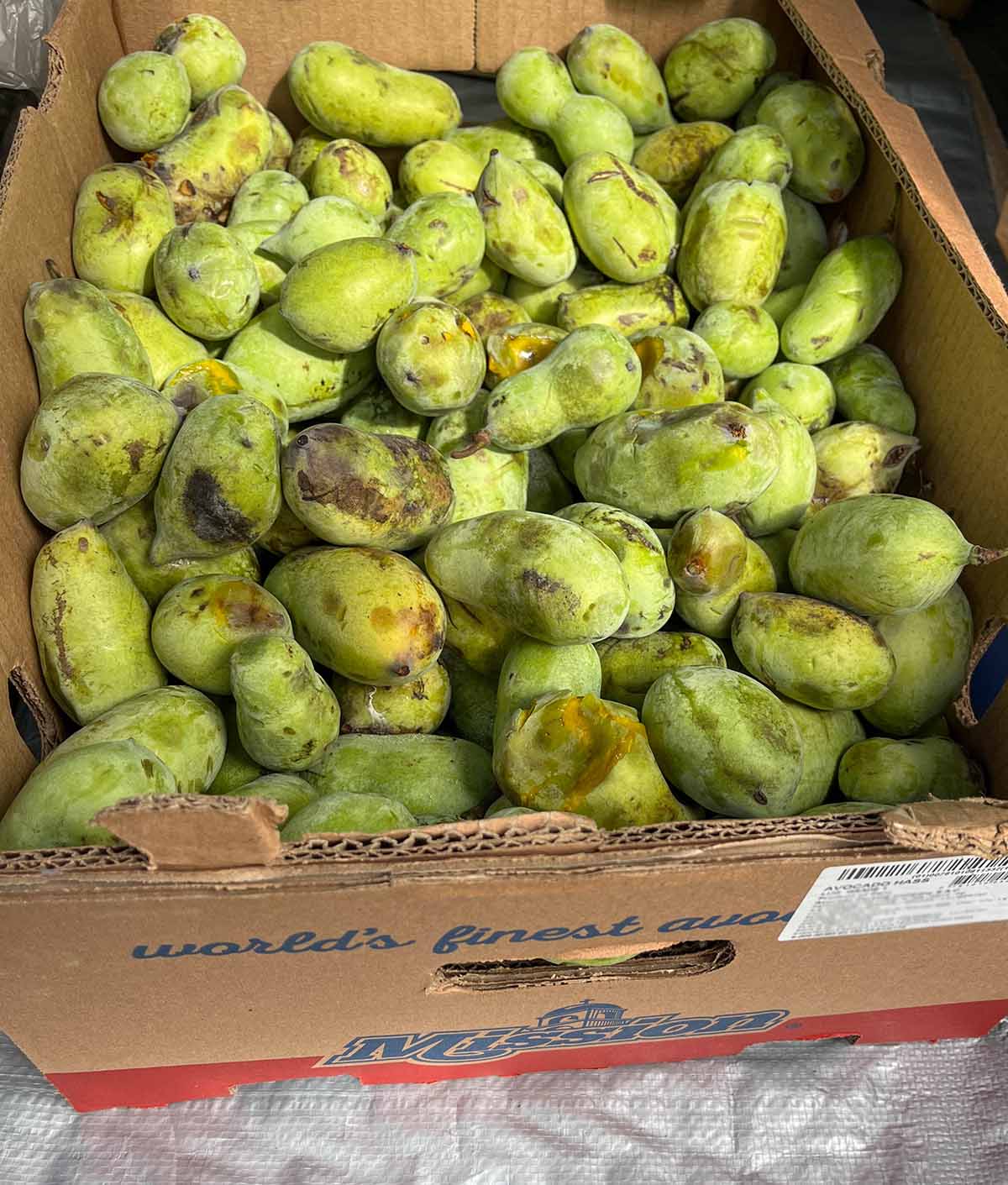
What are pawpaws?
Pawpaws are the largest fruit native to North America. Their botanical name is Asimina triloba and are sometimes spelled as paw paw or papaw. They are not to be confused with papaya, which confusingly are called pawpaws in some cultures.
The pawpaw's tropical flavor is highly prized but the fruit is very hard to find because they don't fit well into the agricultural models that require shipping and storage.
I belong to a garden club with members who share the fruit from their pawpaw trees, and I am now growing some myself as well (Shenandoah and Susquehanna varieties). This guide shares my personal experience, as well as information I've gathered from researchers and other growers.
Jump to:
When is pawpaw season?
Pawpaw season starts in August and September in more southern states like Kentucky or South Carolina. They ripen a little later in northern states like Pennslyvania, Ohio, and Illinois, where they are in season between September and October.
What do they taste like?
Pawpaw fruit has a creamy, custard texture that tastes like a banana-mango cross, with a hint of citrus or pineapple. Wild varieties often have a softer texture, while modern cultivated varieties (like Shenandoah) resemble the flesh of a ripe (but soft) avocado.
The skin is green, even when ripe, and the sunny-yellow flesh contains hard, inedible, lima-bean sized seeds.
Don't eat the skin or the seeds - they aren't good for you.

How do you eat pawpaws?
If you are able to get your hands on just a few of them, eat them fresh. But be warned, they are messy!
Cut them open lengthwise, like an avocado. Your knife will be stopped by the seeds, so cut around the whole thing then twist it open. Scoop the flesh out with a spoon.
The flesh often sticks to the seeds, so a lot of people scoop out some flesh, eat around the seeds with their teeth, then spit out the seeds (similar to eating olives with the pits still in).
The flesh is too soft to dice, but is happily pureed. They work well in almost any recipe that calls for pureed mangoes or mushed bananas, like quick breads, muffins, puddings, custards, and ice creams.
Try my pawpaw cookie recipe with pawpaw cream cheese frosting.

How to remove the seeds
As I mentioned earlier, pawpaw flesh clings to the seeds. It's a real time-consuming task - sorry, I wish I could tell you otherwise. Some people use a knife and scrape the flesh off the seeds. I personally prefer using a spoon.
I remove the seeds from the fruit and set them on a wooden cutting board (because they slip less than on a plate). I use a spoon to scrape the flesh off while holding the seed steady.
Another option is to de-seed the fruit and put the seeds in a strainer. Smush them around but be careful not to grate the seed hulls, as the seeds cause digestive and other issues.
Storage & handling
Pawpaw fruit needs to be picked when ripe since they don't ripen once picked. Most often, growers shake the tree to make ripe ones fall to the ground to be collected. This often results in bruising, shortening their shelf life.
When people say this fruit has a short shelf life, they are not exaggerating. They will last a few days on the counter if you picked them yourself, or 1-2 weeks in the fridge.
When I plan to bake with pawpaws, I like to remove the flesh one day (since it's a time consuming process) and bake with them the next. The flesh stores well in sealed container in the fridge.
I've seen a general guide or two suggest the flesh oxidizes, but that has never happened to me. I've stored the flesh in a sealed container for at least 2 days in the fridge and it has stayed bright yellow.
Pawpaw flesh can also be frozen, while other people freeze them whole. Neither of which I have done personally. Some people report the flesh not tasting as good after thawing, but I unfortunately don't have specifics for you. Maybe next season!

Where can you find pawpaws?
These are probably the hardest fruit to get your hands on.
- Grocery stores: extremely unlikely to sell them
- Farmers markets: growers are few and far between, but if you do enough research you might find a seller at a market in your county
- Pawpaw festivals: might be near you!
- Grow your own: fruit in 2-5 years
- Forage: takes research and a lot of luck to find them
- Buy online: $15-25 / pound
Grocery stores
Pawpaw fruits bruise easily and have a very short shelf life once picked. This makes them nearly impossible to sell at grocery stores. You might find them in a specialty market, but even that is very unlikely.
Farmers markets
Farmers markets aren't likely to have them either, unless you are lucky enough to be near a farmer who likes them enough to grow and offer them for sale in the 3 week window where they ripen on the tree.
Look up local farmers markets for a list of farmers. Go to their websites (or give them a call) to see if they grow and sell pawpaws. Don't forget to ask when you should expect the fruit to be available at the market!
Festivals
More than 10 states have annual pawpaw festivals, including Ohio, Pennsylvania, Kentucky, and North Carolina. If you live near one, this is your best bet to buy the fruit, possibly some trees, and definitely fun foods.
If you live near Chicago, I usually go to the Midwest Fruit Explorer Show at the Chicago Botanic Garden in October. They usually have pawpaws from members (at the very end of their seasonality, so they won't last long!)
Grow your own
You can grow them, but you'll need to plant 2 complementary varieties to ensure pollination. They get 15-25 feet tall and wide, depending on the variety. If you have the space, they are beautiful, tropical-looking trees that grow in a pyramidal shape.
Forage
Another option is to forage for them. Their native range includes the midwestern states south of the Great Lakes, stretching over to the east coast as far north as New York, and then south down to parts of Florida's panhandle.
They are actually an understory tree, happily growing in the shade of taller trees in the forest. They are often found near river banks and floodplains as well.
Pawpaw trees can sometimes be spotted along public walking or hiking trails. If you know how to identify them and foraging is allowed, pick some to take home.
Buy online
To buy pawpaws online, start looking for them to go on sale mid-August, as they sell out quickly. You likely won't find them for sale until the last week of August or first week or two in September. But you want to look early, because by mid-September, I've seen most sites sell out of stock.
A warning though - they are very expensive to buy online.
Earthy delights sells fresh pawpaws online for $45 for 3 lbs or a 10-pound case for $142. They also sell a 2-pound pack of frozen flesh for about $50. Note, this is very expensive. I suggest this only if you want to splurge because you've never tried them.
Pawpaw products
Since fresh pawpaws can be hard to find, you can also look for other products like a jam, or this pawpaw-maple vinaigrette.
Alternatively, keep your eye out for pawpaw beer at local breweries. As Serious Eats reports, "Pawpaw-flavored craft beer is a dynamic little pocket of the pawpaw world, and it's perhaps one of the most accessible ways to bring pawpaws to the people."
Questions & more resources
I've been lucky enough to belong to a garden group with people who grow pawpaws. It's a fun treat every year, and now I am growing my own. If you have any questions about this fruit, leave a comment. I will answer what I can, and try to ask some experts if I can't!
See what else is in season at the same time as pawpaws.




Leave a Reply